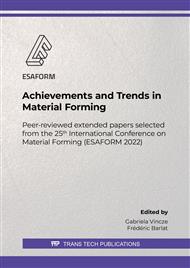[1]
P.K. Saha, Aluminum extrusion technology, ASM International, Materials Park, OH, USA, (2000).
Google Scholar
[2]
T. Sheppard, Extrusion on Aluminum Alloys, Kluwer Academic Publisher, (1999).
Google Scholar
[3]
A.F. Ciuffini at al., Surface Quality Improvement of AA6060 Aluminum Extruded Components through Liquid Nitrogen Mold Cooling, Metals, 8 (2018).
DOI: 10.3390/met8060409
Google Scholar
[4]
T.J. Ward, R.M. Kelly, G.A. Jones, J.F. Heffron, The effects of Nitrogen - liquid and gaseous - on aluminum extrusion productivity, JOM - The Journal of The Minerals, Metals & Materials Society, vol. 36, pp.29-33, (1984).
DOI: 10.1007/bf03339208
Google Scholar
[5]
P. Stratton, Raising productivity of aluminium extrusion with nitrogen, International Heat Treatment and Surface Engineering, 2 (2008) 105-108.
DOI: 10.1179/174951508x429221
Google Scholar
[6]
L. Donati, A. Segatori, B. Reggiani, et al, Effect of liquid nitrogen die cooling on extrusion process conditions, Key Engineering Materials, 491 (2012) 215-222.
DOI: 10.4028/www.scientific.net/kem.491.215
Google Scholar
[7]
A.J Norwood, et al., Analysis of cooling channels performance, International Journal of Computer Integrated Manufacturing, 17 (8) (2004) 669 – 678.
Google Scholar
[8]
M.V. Lurie, Modeling of Oil Product and Gas Pipeline Transportation, WILEY-VCH Verlag GmbH & Co., KGaA, Weinheim, (2008).
Google Scholar
[9]
B. Reggiani, L. Donati, Prediction of liquid nitrogen die cooling effect on the extrusion process parameters by means of FE simulations and experimental validation, Journal of Manufacturing Processes, 41 (2019) 231-241.
DOI: 10.1016/j.jmapro.2019.04.002
Google Scholar
[10]
R. Pelaccia, M. Negozio, L. Donati, B. Reggiani, L. Tomesani, Extrusion of Light and Ultralight Alloys with Liquid Nitrogen Conformal Cooled Dies: Process Analysis and Simulation, Journal of Materials Engineering and Performance, (2021).
DOI: 10.1007/s11665-021-06320-z
Google Scholar
[11]
R. Pelaccia, M. Negozio, B. Reggiani, L. Donati, L. Tomesani, Analysis and optimization of cooling channels performances for industrial extrusion dies, ESAFORM 2021: Proceedings of the 24th International Conference on Material Forming 3686:1-11. Liège, Belgique. https://doi.org/10.25518/esaform21.368.
DOI: 10.25518/esaform21.3686
Google Scholar
[12]
COMSOL® Multiphysics (Version 5.4). Modelling software; https:// http:/ www.comsol.it.
Google Scholar
[13]
M. Nourani, A. S. Milani, S. Yannacopoulos, On the effect of different material constitutive equations in modeling friction stir welding: A review and comparative study on aluminum 6061, International Journal of Advances in Engineering & Technology, 7 (1) (2014) 1-20.
DOI: 10.4236/eng.2011.32017
Google Scholar
[14]
C.M. Sellars, W.J. McG Tegart, Hot workability, Int Metall Rev, 17(1) (1972) 1–24.
Google Scholar
[15]
E.W. Lemmon, M.O. McLinden and D.G. Friend, Thermophysical Properties of Fluid Systems in NIST Chemistry WebBook, NIST Standard Reference Database Number 69, Eds. P.J. Linstrom and W.G. Mallard, National Institute of Standards and Technology, Gaithersburg MD, (2018).
Google Scholar
[16]
https://www.esteco.com/modefrontier.
Google Scholar


